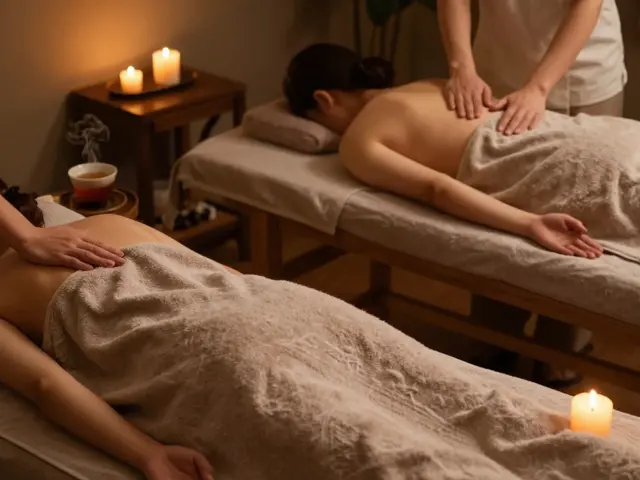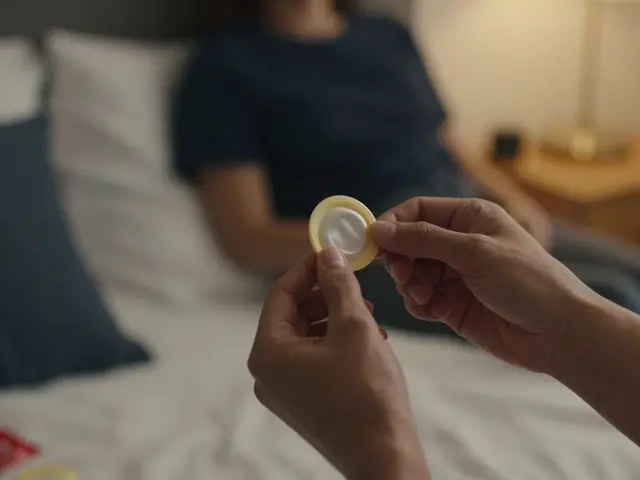You might think classic vaginal sex is pretty straightforward—something everybody knows all about. But here's the twist: there's a whole world of sensuality hidden in this most familiar act, and even the most seasoned couples admit they’re still learning how to make it more intimate, thrilling, and truly satisfying. Sometimes, it just gets overlooked in all the hype about trying new things, when in fact, the classic can be transformed into the extraordinary.
The Science and Sensuality of Vaginal Sex
Our bodies are wired for pleasure in ways you may not expect. Most people know the basics, but many don’t realise just how complex and fascinating vaginal sex can be from a scientific perspective. For starters, the vagina isn’t just a uniform tube—it changes shape and size, even during a single sexual encounter, adjusting and accommodating for arousal and comfort. Blood flow increases, lubrication naturally kicks in, and for a lot of women, the vaginal walls become more sensitive than at any other time. That makes timing and touch absolutely critical.
On top of that, every woman’s anatomy is unique. Some people might have a few more sensitive areas toward the front (we’re talking about the G-spot, which sits just a couple of inches inside, facing the belly button), while others report the deepest pleasure from the cervix, or even from the area around the vaginal opening, with the right pace and pressure. The clitoris, while mostly visible outside, actually wraps internally around the vagina in a wishbone shape—meaning that penetration stimulates it for a lot of women, not just external contact. Interesting, right?
Now let’s talk about hormones—because the brain’s as important as the body here. During vaginal sex, there’s a big release of oxytocin, better known as the ‘cuddle hormone’, which is linked to feelings of bonding and trust. Couples who have regular sex often show increased wellbeing on psychological checklists, and it’s not just about the physical act itself. The afterglow—that satisfied, peaceful feeling—can last up to 48 hours, according to a study published in the journal Emotion in 2017. It’s like your body’s way of encouraging you to keep coming back for closeness.
It doesn’t stop at pleasure and hormones either. Sex can do some pretty cool things for the heart, skin, and even pain tolerance. For example, vaginal sex has been shown to count as moderate exercise. If you’re keeping track of calories, it can burn between 70–100 calories per session (obviously depending on enthusiasm levels and duration). Heart rate increases, endorphins spike, and stress melts away. A survey in the British Medical Journal even found regular sexual activity can decrease the chance of heart disease mortality among men. There’s also evidence that some women experience reduced period pain because of contractions triggered by orgasms. Forget the old myths—making time for sensuality is actually good for your overall health.
Check out the stats in this table—maybe some of these will surprise you:
| Fact | Description/Study |
|---|---|
| Most sensitive vaginal area | Anterior wall, roughly 2-3 inches in (source: Journal of Sexual Medicine) |
| Oxytocin levels after sex | Increase by 300% (source: American Psychological Association) |
| Afterglow duration | Up to 48 hours (source: Emotion, 2017) |
| Calorie burn per session | 70–100 calories (source: Harvard Health Publishing) |
| Clitoral structure | Internal wishbone shape wrapping around vagina (source: O'Connell et al., 2005) |
This deeper look proves classic vaginal sex is nowhere near as ordinary as people sometimes assume. There’s as much to discover in a familiar act as there is in trying something new.

Making It More Sensual: Tips for Deeper Intimacy
If you want sensuality to last, forget autopilot. The real magic happens when you ditch the script and pay attention—to yourself, to each other, to what feels good in the moment. Sensuality isn’t just about technique; it’s about presence and curiosity. That’s true whether you’ve been together for five months or five decades. So what actually helps couples get more out of classic vaginal sex?
- Slow down completely. Most people rush. Take at least 15 minutes before penetration just for touching, kissing, or exploring. The body warms up and relaxes, so everything feels better.
- Talk, not just with words. Sounds, sighs, and even laughter all build connection and arousal. Don’t be embarrassed to make noise or show your reactions—it signals trust, which ramps up sensation for both of you.
- Change your environment. Sometimes just moving somewhere else—like from the bed to the floor, or under the shower—can trick your brain into waking up. Even small changes, like lowering the lights or playing music, can make everything feel fresh.
- Use hands, not just bodies. Vaginal sex is more than just in-and-out. Try using your fingers (or your partner’s) during penetration, or experiment with toys. A gentle hand on the lower back or hip can be wildly intimate.
- Mix up the angle. Don’t stick to the same three positions. Angling the hips with a pillow, shifting knees, or trying face-to-face sitting positions give new sensations and can help you reach those internal pleasure spots.
- Don’t ignore the clitoris. During vaginal sex, adding external touch (with your hand, your partner’s, or even a small vibe) can completely change the experience and make orgasms way more likely and intense.
- Let go of goal-chasing. Forget the pressure to orgasm or to perform a certain way. Sensuality is about enjoying the ride. Sometimes, just lying together afterward, catching your breath, is more connecting than anything else.
Men and women can have very different preferences, which is completely normal. It’s all about finding the rhythm you both like—communicating before, during, and after sex without judgment. A good tip for couples is to have a “debrief” later, when nobody’s naked, and talk about what each person liked most (or least). This builds trust and helps you keep experimenting together.
Another surprisingly underused trick? Breathing—together. When both people slow their breathing to match, it naturally calms the nervous system. This makes everything feel more relaxed and intimate. Or, if you want to go the other way, a burst of fast breathing (kind of like giggling) between thrusts can make things more playful. Little tweaks like this can entirely reshape how familiar sex feels.
If one partner—or both—experiences pain, it’s not something to brush aside. Most discomfort comes from going too fast, not using lube, or anxiety about performance. A good water-based lubricant can fix most dryness issues on the spot (and opens up new possibilities for slower, more sensual movement). For those with chronic discomfort, medical advice makes a world of difference, and many clinics in the UK are now well-staffed with sexual health specialists who can help without embarrassment.
Your senses can make a regular encounter feel utterly new. According to a 2022 YouGov poll, couples who deliberately introduced “sensory play”—like blindfolds, different textures, or flavored lubes—reported nearly twice as much satisfaction compared to those who stuck to automatic routines. The lesson? Don’t be afraid to experiment even with the classics.
At the heart of all these tips is curiosity. If you treat every encounter like it’s the first time, your body and brain pick up on newness and energy. That makes classic vaginal sex something you’ll never outgrow—and makes it easy to rediscover, even after years together.

Keeping the Spark: Real-World Practices for Long-Term Lovers
One of the challenges that almost every couple faces is keeping things exciting over time. It’s not about acrobatics or constantly chasing new positions—it’s actually the little things that bring back intimacy and surprise. The happiest couples, according to a 2023 survey out of Oxford University, share two things: honest communication and creative routines. What’s more, 73% of long-term couples said that regularly making time for classic vaginal sex—even if it’s just once a week—helped them feel more connected (and happier as a couple overall—yes, people still fill in those long relationship satisfaction surveys).
If you want a little inspiration, here’s a quick list of what real couples say reinvigorated their classic sessions, even after years together:
- Turning off all devices for the night. No distractions, just presence.
- Revisiting firsts: First shared hotel room, first favorite date song, first type of perfume—they found nostalgic moments primed their brains for romance.
- Setting the scene just for sensuality. Bringing in new scents (like candles or room spray), textures (a soft blanket, silky sheets), or foods (chocolate, strawberries) wake up new senses.
- Planning it, instead of waiting for the right mood. Scheduled sex is not less sexy—it removes anxiety and adds anticipation.
- Joking and playing around, trying to keep things lighthearted. Laughter is a huge aphrodisiac.
- Relearning each other’s bodies. Over time, preferences change—what drove her wild at 25 might not be the same at 45. Checking in every few months encourages open discovery.
Data also supports the importance of scheduled connections. Regular couples who made a date—even just once a fortnight—reported higher satisfaction, less stress, and less conflict. Turns out, effort pays off more than spontaneity for most people navigating busy lives. Modern science says so, but honestly, common sense backs it up too.
For couples experimenting with different methods of contraception, communication is vital. Some birth control—like certain pills or IUDs—can change natural lubrication, or alter desire levels. Being tuned in to these shifts, and being patient, helps both partners adapt and keeps things smooth (emotionally and physically).
Even if you’ve hit a rut, research shows that mixing things up outside the bedroom can spill over to your sex life. Couples who started new activities together—think dance lessons, hiking, or trips to a new city—often rediscovered desire. Novelty and partnership, in any form, make old habits feel fresh again.
Finally, don’t forget touches and intimacy outside of sex. Cuddling, kissing, or even holding hands regularly can keep you in sync and make the actual act of classic vaginal sex feel like a fuller, richer experience. When daily stress and routine start building up, even small acts of affection can reignite the spark.
At its best, classic vaginal sex is a shared adventure. It’s the ultimate reminder that comfort and excitement can live side by side, as long as you bring a little curiosity, care, and playfulness each time. No need for gimmicks when you master the art of the familiar—because that’s where real passion grows.








